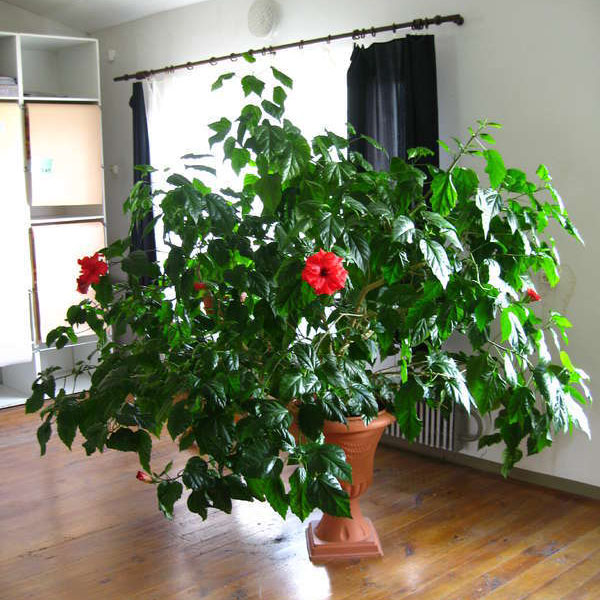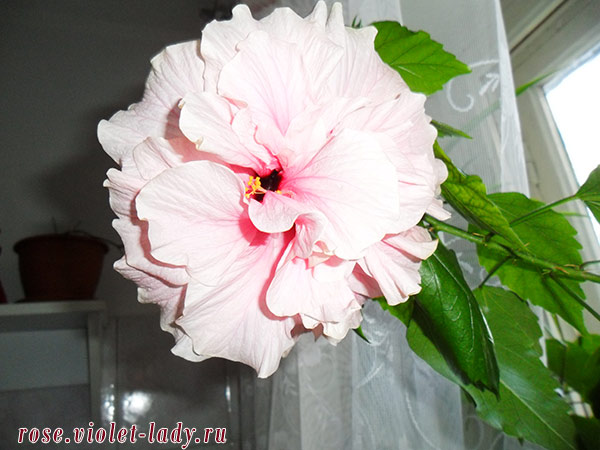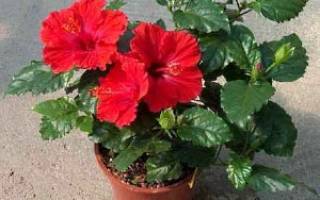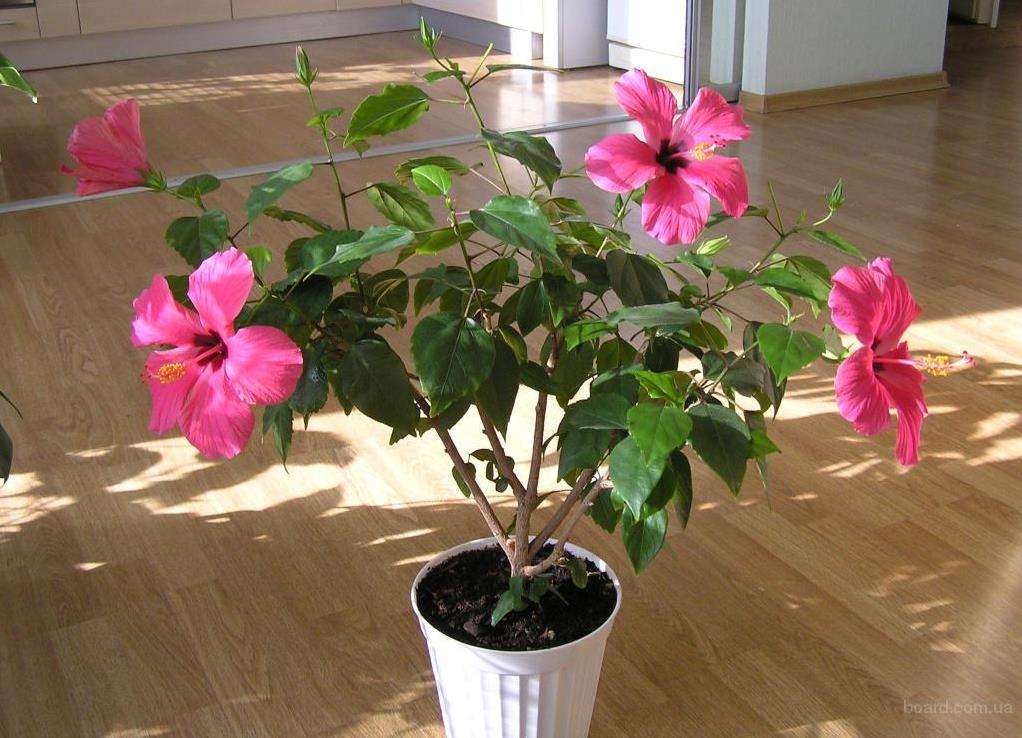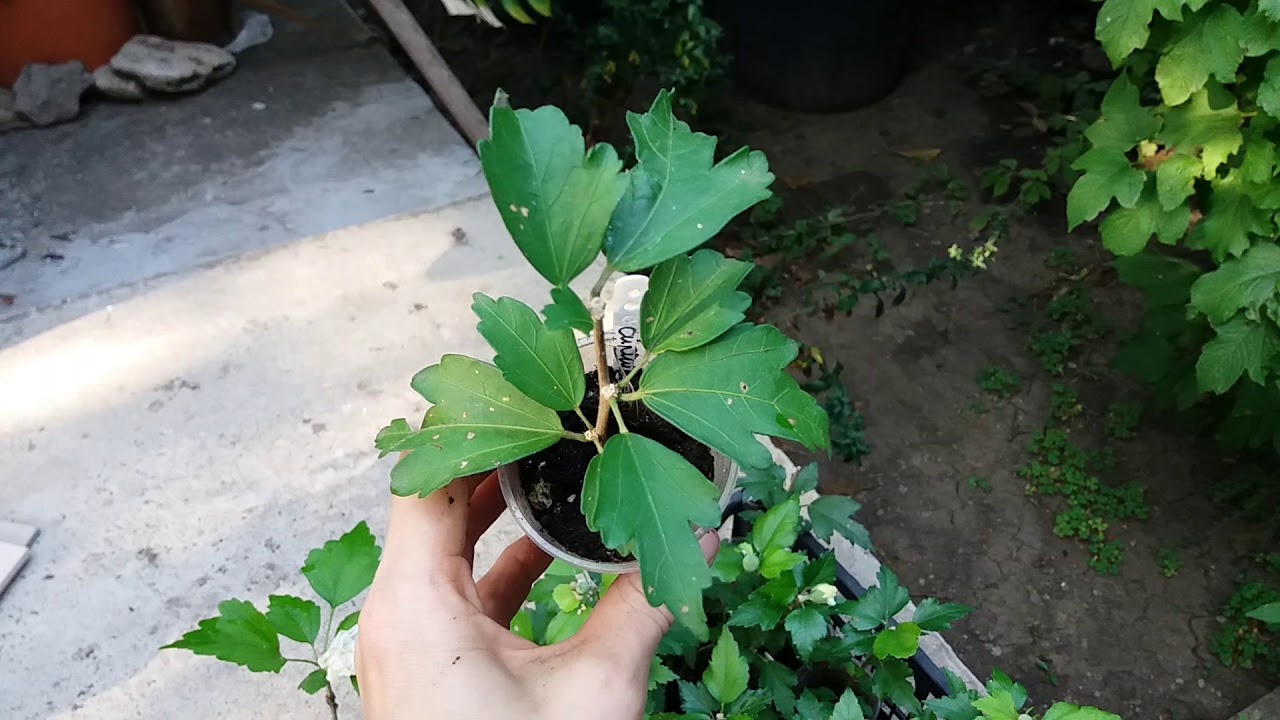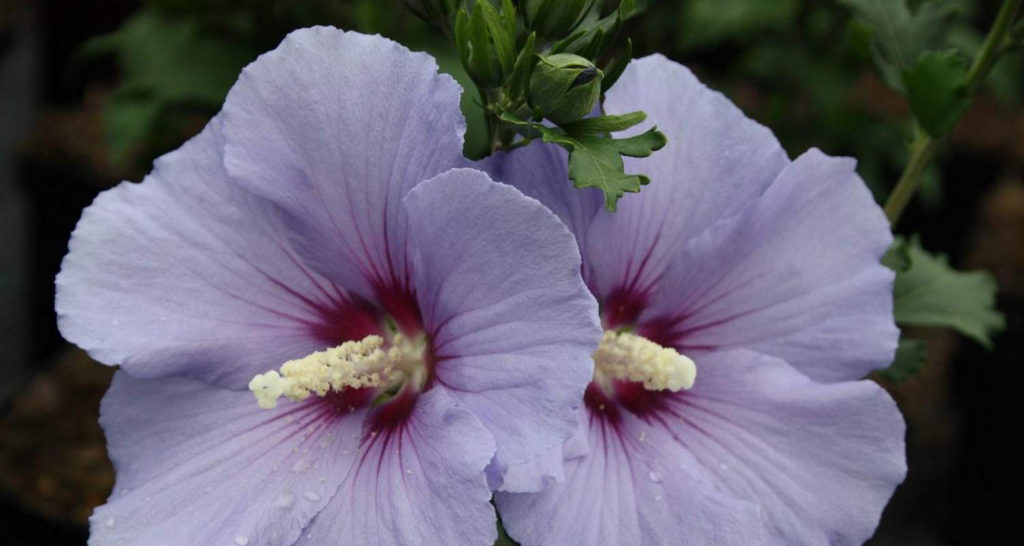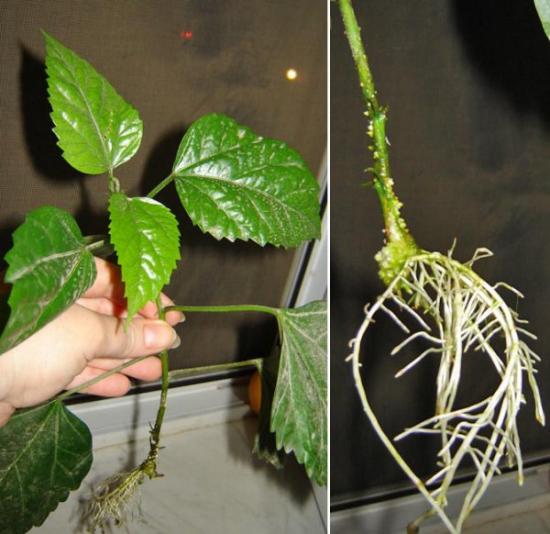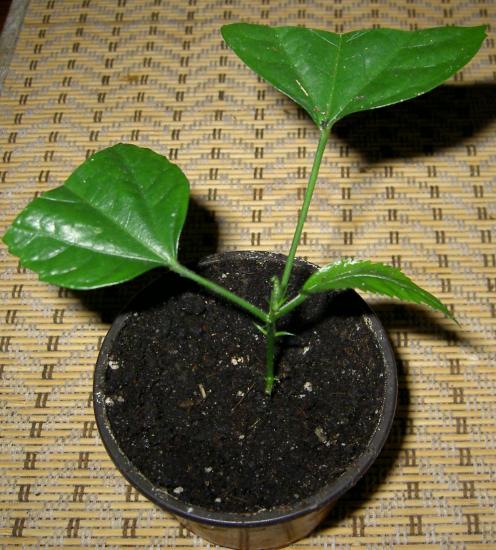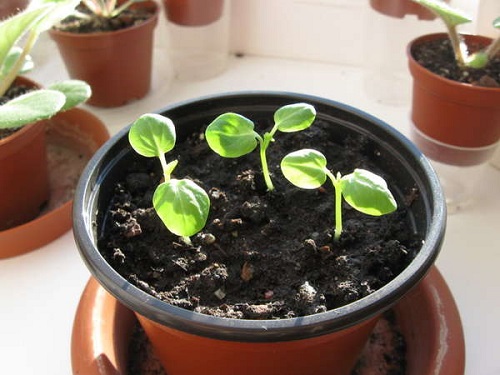Hibiscus - reproduction and rooting at home

Hibiscus, or Chinese rose, is not easy to propagate compared to other indoor flowers. Usually it is bred by cuttings, but some growers prefer growing a flower from seed. We will tell you in detail about each of these methods of reproduction of hibiscus and determine their advantages and disadvantages.
Advantages and disadvantages of grafting
Cutting is a vegetative way of propagation of a plant. This method is quite simple, it is within the power of even a novice florist.
Another important advantage of this method is the fact that the hibiscus grown from the cuttings will please with flowering in a year, while retaining all the varietal characteristics of the mother plant (flower color, its doubleness).
The root system formed by cuttings is stronger and more powerful than those plants that have been propagated by other methods, for example, by seeds (read here how to grow indoor hibiscus from seeds, as well as further caring for a flower after planting).
You can learn more about the reproduction, planting and further care of hibiscus in the house and garden, as well as see a photo of the flower, here.
What time of year is it better to propagate the plant?
The best time to cut cuttings is from April to August. Experienced flower growers recommend rooting in May, since it is in this month that the plant is most active: new cells appear and develop, all metabolic processes proceed at an accelerated pace. If the hibiscus is rooted in the last month of spring, the probability that the plant will take root will be close to 100%.
Cuttings can be carried out in winter, but the rooting process will be slower and it will not always be possible to achieve a positive effect, since in winter there is no lighting, those temperatures that are necessary for the shoot.
Can you propagate by leaf?
A hibiscus leaf that is cut and placed in water can root. Planted in the ground, it will be green and beautiful in appearance. It is not recommended to use a leaf for propagation: a full-fledged plant will not appear from it.
If you use a leaf "with a heel" for reproduction, then it will already be considered a cuttings, it will take root well and eventually turn into a full-fledged plant.
: Syrian hibiscus - planting and care, growing rules
How to care for hibiscus
Hibiscuses love abundant watering and do not tolerate the drying out of an earthen coma - then their leaves instantly droop. But they do not like the bay either; plants may die from excess moisture. In winter, watering is reduced.
It is better not to leave water in the pallet. The acceptable temperature for keeping the flower is from 7 to 30 degrees, but in extreme heat it should be removed in the shade. To lay flower buds, the plant needs a temperature of 15 degrees Celsius.
In a light arrangement, hibiscus blooms much better than in the shade. These plants are able to withstand even direct sunlight, they are even desirable for flowering (about 5 hours a day).
They can bloom all year round if there is enough light, but buds are also growing far from the light source (usually only 1-2).
The classic Chinese hibiscus flower only lasts 1 day, but the Florida hybrid can last up to 5, depending on the variety.
Often, hibiscus can suffer from various diseases or pests. We will tell you how to deal with them here.
For propagation of the Chinese rose, use:
- seeds;
- cuttings;
- dividing the bush;
- layering.
Seed propagation
After the bud of the plant withers, seeds appear. To grow hibiscus from seeds, preliminary preparation for sowing is required.
You need to pour water into a container, add a root formation stimulant and soak the seeds for 12 hours.
After that, rinse them, degrease in a weak solution of potassium permanganate, place in a damp cloth and leave in a warm place.
After the sprouts appear, moisten them with water, ventilate. Plants planted in pots quickly sprout new shoots. It begins to bloom after 3 years, not always with this method the properties inherent in the original species are preserved.
How to grow from a cuttings?
Decorative hibiscus is distinguished by a variety of colors, they reproduce easily under certain conditions. When propagating by cuttings, it is necessary to properly root the cutting from a plant that you like. When choosing petioles, it should be remembered that there must be at least two internodes on it.
There are several ways to root cuttings:
Reproduction of elite plants
There are many varieties of hibiscus. Among them there are plants with double flowers. Also with extraordinarily beautiful colors and shapes that are significantly different from ordinary culture. In view of this diversity, many gardeners have the question of how to root varietal hibiscus. You have to be patient here. The fact is that elite specimens release root shoots much longer than classic ones. Sometimes this process is delayed for them for six months.
It is best to root varietal hibiscus in water. Three basic conditions are required: warmth, light and sufficient air humidity. You can use zip bags as a material to create a greenhouse effect. With such a device, you do not have to constantly disturb the seedling. It will be enough just to open the bag once a week and release excess moisture from it. A light bloom (callus) will first appear on the part of the cuttings in water, after a while roots will gradually begin to grow.

Herbaceous hibiscus cuttings
Herbal hibiscus belongs to hybrid varieties; it can be cut by cuttings only in early summer during the regrowth of shoots. So, before the first cold weather, the seedlings will have time to take root and the likelihood that the flower will survive the winter increases.

In order for grafting to be successful, it is recommended:
- On the day of disembarkation, in the morning, water the bush abundantly so that the water soaks the earthen lump. In the evening, you can proceed directly to the separation of the sprouts. It is recommended to choose young shoots that grow at the base of old bushes;
- Do not cut the shoot, but pull it out with a jerk to the side. The result should be a seedling with root buds or a white tint at the base;
- Cut off the top of the sprout, leaving some foliage;
- The base of the seedling is sprinkled with root;
- The new shrub hole should be filled with a mixture of brown high-moor peat, sand and charcoal. The mixture must be watered thoroughly;
- The stalk is planted and covered with a cut bottle on top until rooting. Additional watering is not necessary;
- It is recommended to remove the bottles for a few minutes every day. If it's hot outside, you should additionally spray the seedlings;
- After two and a half to three weeks, rooting occurs. Now it is worth starting to acclimatize the seedling. To begin with, it is recommended to open it daily for ten minutes, gradually increasing this time, hardening the hibiscus. On average, complete habituation to new conditions occurs within a week.
If the resulting plant looks weak at first, it can be tied to a peg. In this case, it is better to take a peg longer, for several garters.

Reproduction of hibiscus at home is a painstaking business, but does not require phenomenal knowledge.
We offer you to watch a video about reproduction by cuttings of Syrian hibiscus, herbaceous:
It is enough desire, attentiveness and a few hours of free time to get several from one beautiful flower and there, perhaps, a whole greenhouse, which will delight the eye.
Is it possible to plant the offshoot in open ground?
The Chinese rose is a thermophilic plant and is not suitable for our climate. With the exception of garden hibiscus, adapted for temperatures down to -30 degrees. The place for the plant is chosen bright and protected from the wind. The soil must be light and nutritious, water must penetrate deeply.
Planting is carried out in the spring, when the soil warms up well. Pit preparation:
- The planting hole should be twice as deep as the hibiscus root system.
- A 15 cm thick drainage layer made of broken bricks is laid.
- The next layer is 10 cm thick from sand.
- Compost layer 15 cm.
- The last layer is sandy, 15 cm deep.
A nutritious soil is compiled for planting:
- 2 pieces of soil from the pit;
- 4 parts of peat;
- 1 part sand.
A seedling is placed in the prepared hole so that the neck is slightly covered, and it is covered with prepared soil.
How to propagate a Chinese rose at home
The beauty of hibiscus is always delightful, and the splendor of the colors is pleasing to the eye. The Chinese rose, as this plant is also called, is found in almost every home. Under natural conditions, hibiscus reproduces by its own seeds. At home, most often, this process is carried out in a vegetative way using cuttings.
 Chinese rose
Chinese rose
With the arrival of spring, every amateur florist strives to put his collection of plants in order. A special place is given to reproduction, and any grower needs to know how to do this at home.
At home, you can use both methods of propagation of decorative hibiscus:
- The seed method, in which hibiscus seeds are placed in the soil.
- Vegetative method - cuttings, which must first be rooted.
Growing features
Failure to comply with some of the nuances can lead to the fact that the plant will look lethargic and, as a result, may die altogether. In the end, all your labors will be in vain.
It is important not only to carry out a successful rooting process, but to continue to take care of this wonderful flower. To constantly admire the flowering of a Chinese rose, you need to create an optimal atmosphere for it.
She does not like too dry air, so it is better not to place a flowerpot with a plant near the battery. To avoid the wilting of the flower, you need to carry out spraying procedures.
You should not choose too wide a flowerpot for transplanting a plant. They seem to feel the size of the container and stop developing intensively - the smaller the flowerpot, the more buds there will be on the bush
It is important to understand here that the roots of the plant should not be left too much space. They also feel bad in plastic containers.
Chinese roses bloom for a long time.
You need to feed the plant starting in March. This should be done once a week. For maximum assimilation of nutrients, you need to alternate the application of fertilizers - first feed the culture with a mineral complex, and add organic matter in the next step.
It is important to regularly wipe the dust on the leaves or carry out hygiene procedures by spraying. It is also necessary to protect the bush from direct sunlight.
Especially if you have district heating where the air is usually too dry, you need to pay due attention to culture. All care measures should be performed in moderation.

Cuttings: how to root cuttings?
To propagate a Chinese rose by grafting, you can use the material left over after pruning the bushes. How to take a scion correctly? A young, not stiff stalk 8-12 cm long, with at least three internodes, is selected, preferably cut in January-February. There are two types of planting - into the water and directly into the ground.
Instructions for planting a cutting of a Chinese rose in water:
- A vessel, preferably made of dark glass, is filled with water.
- A stalk is placed in it.
- Top, to increase humidity, is covered with a cap, glass jar or plastic container.
- The cuttings take root in a month.
- After the roots appear, the plant is transplanted into the ground.
Reference! For a young plant, the addition of sphagnum moss to the soil is very useful.
Instructions for planting a Chinese rose directly into the ground:
- Half of the leaves are removed from the cutting.
- A pot with a volume of 0.5 liters is prepared - it is washed and doused with boiling water.
- Before planting, the soil is spilled with boiling water.
- Drainage is laid at the bottom, the pot is filled with loose, water and breathable soil.
- The stalk is buried 1.5-2 cm into wet soil.
- Cover with a jar on top or put on a package (conditions for a mini-greenhouse are created).
- The pot with the plant is placed in a bright place with a temperature of 23-25 degrees, but not in direct sunlight, and is not rearranged from place to place.
- If condensation occurs, ventilate.
- The stalk begins to grow - an increase in airing time, if the hibiscus does not lower its leaves - remove the greenhouse.
Reproduction of hibiscus by cuttings retains varietal characteristics, and the plant blooms in the first year.
We suggest you watch a video about hibiscus cuttings:
Read other articles about hibiscus on our website:
- Why is it considered the "flower of death" and is it true that it cannot be kept in the house?
- Your garden decoration is Chinese Rose Angel Wings.
- Why doesn't hibiscus bloom at home?
A handsome and useful garden dweller
The typological features of the plant include:
- large double, semi-double flowers, reaching a diameter of 20 cm;
- petiolate leaves with a jagged edge;
- bright color of the corolla;
- the fruit is a five-leaf box filled with small seeds.

Pan-Asian countries are considered the birthplace of hibiscus. In this regard, the plant received its second name - the Chinese rose. Like other mallow Chinese roses:
- hygrophilous;
- sun-loving;
- prefer light, sandy soils;
- need nitrogenous and phosphorous baits.
It should be noted that hibiscus flowers and leaves have medicinal properties. A decoction of the buds is used to solder patients with dysentery, hemorrhoids, inflammatory diseases, and stomach ulcers. The acidic enzymes contained in the petals stimulate the production of bile and the elimination of toxins from the body. Decoctions of dried buds and alcoholic whisk lotions soothe sore skin, reduce irritation and help prevent acne breakouts.
Hibiscus tea is a long tea with the addition of Sudanese rose petals (a type of garden hibiscus) that stimulates appetite, lowers blood pressure and is an effective immunomodulator.

The collection of inflorescences is carried out during the active growing season - from May to October. During drying, the buds are not disassembled into petals, but are placed in a shaded, well-ventilated place. Hibiscus broths rinse hair, wipe the skin of the face and neck, and also fill healing phyto-baths.
Plant species and their description
At home, hibiscus is called the flower of love, where it is a symbol of beauty and femininity. In Hawaii, local girls adorn their hair with these bright colors on holidays. The plant belongs to the Malvov family, which is quite numerous. Hibiscus grows as:
- decorative trees;
- herbaceous varieties;
- dwarf shrubs;
- shrubs.
Inflorescences can be funnel-shaped, double and simple. Regardless of their shape, they all have an exotic, attractive look. There is a yellow, crimson, purple, lilac, white color. There are also two-color varieties. Treelike hibiscus grown in standard form looks great as a tapeworm.
Low-growing varieties are suitable for placement on curbs.Herbaceous hibiscus is in harmony with ground cover roses and plants with decorative leaves. Garden hibiscus begins to bloom in late June, flowering ends in early October. Frost-resistant varieties tolerate a significant drop in temperature (down to -20 ° C).
Popular varieties
Since several varieties of hibiscus are suitable for the garden, you can choose the one that suits your taste. The most popular are the following types:
- Syrian hibiscus, it is also called garden. Grows in a neat bush up to 3 meters high. The opened inflorescences resemble saucers. Flowering begins in July and lasts until autumn. There are varieties with simple and double flowers in white, red and pink colors. In winter, this species can withstand up to -25 ° C. In summer, it needs warm weather for flowering. Prefers neutral soil and sunlit locations.
- The hibiscus is terry or changeable. China is considered the birthplace of the plant. A powerful shrub that grows up to 3 meters in height. Can be grown in standard form. The inflorescences are pale pink in color. The flowers are often double, but there are also simple ones. The diameter of the blossoming buds reaches 10 cm. When grown by a bush, it requires only sanitary pruning, it is formed independently.
- Herbaceous hibiscus. Plant with powerful, erect shoots up to 3 m high. Large leaves resemble sunflower foliage in shape. The color of the inflorescences is pink, crimson, white. This type of "love flower" prefers warmth and sunlight. Blooms from August to early autumn. Almost any soil is suitable for this plant. It is considered unpretentious and frost-resistant. In autumn, it is recommended to cut off the entire aerial part of the hibiscus. Blooming next year will come only on new shoots.
- Marsh hibiscus. A versatile perennial that can be grown both in the garden and at home. Its large scarlet inflorescences look like rose flowers. There are black dots in the middle of each bud. This is the most frost-hardy species, in winter the plant is able to withstand temperatures down to -30 ° C.
There is room in the garden for any kind of hibiscus. Its herbaceous forms make it possible to create picturesque compositions, tree-like varieties are suitable for the construction of hedges.
Substrate preparation
We figured out how to root cuttings of indoor hibiscus. Next, let's move on to preparing the soil, in which the flower will grow constantly. It would be nice to get a special composition for citrus crops, add a little sand and vermiculite to it. You can prepare the substrate yourself. For this purpose, it is necessary to take: three parts each of leafy and soddy soil, one each - humus, charcoal and sand. If these proportions are observed, hibiscuses usually develop well, get sick less and live longer.
The Chinese rose feels as comfortable as possible in peat soil. Experienced flower growers advise adding sphagnum moss to it to regulate humidity.
Seed propagation of hibiscus
This method is suitable for growing valuable varieties of hibiscus and for obtaining new ones as a result of crossing. The long period (several years) that passes from sowing to the moment of flowering makes seed reproduction uninteresting for ordinary indoor floriculture lovers. The seed can be purchased in specialized stores or obtained at home by pollinating the flowers with a soft brush. With successful pollination, the calyx does not fall off after a few days, but remains on the plant. Hibiscus seeds ripen in a five-man capsule for a month.
It is advisable to soak the seed in a solution of any stimulant (Epin, Humat, etc.), diluted according to the instructions, for several hours. Place the prepared seeds in a damp cloth and wrap in plastic wrap or a bag. At a temperature of about 25-30 ° C, the seeds begin to hatch as early as 3-5 days.Without waiting for the growth of a long root, they need to be sown in moistened soil, prepared as indicated above for planting cuttings. The seeding depth is 0.5-0.7 mm. The container with seeds must be covered with glass or foil to retain moisture. In a warm place, seedlings will appear on the 7-14th day.
After the formation of 1-3 true leaves, plant the seedlings in separate pots with a diameter of 5-7 cm.Planting and care is carried out according to the rules common to all young plants:
- watering is best done from a pallet, avoiding stagnation of liquid in it;
- do not cool containers with seedlings below + 20 ° С, as this can cause the disease "black leg";
- do not leave seedlings in direct sunlight and dry them out.
Growing hibiscus seedlings need to be reloaded as the roots fill the pot. In good conditions, they grow quite quickly, and vegetatively propagated young bushes can even bloom by the end of the 1st year of cultivation.
Hibiscus: reproduction
Propagation of Syrian hibiscus by seed method
Hibiscus grown from seeds have increased stress resistance, but often do not inherit the varietal traits of the parent plant.
Therefore, amateur gardeners prefer to plant hibiscus garden in vegetative ways. But if you have a desire to conduct a breeding experiment in the hope of getting a new plant variety, then proceed according to the following plan:
- collect brown hibiscus pods, first spreading film or paper bags under the bush so that seeds from ripe pods do not spill onto the ground;
- remove the seeds from the pods;
- test the viability of the seed: 5-10 seeds, wrapped in a damp paper towel, place in a plastic bag and close tightly for 5-7 days. then remove and inspect for swelling or sprouting.
If you find that the seeds are swollen, and some have tiny sprouts, then the seed is suitable for sowing. If there are no such signs, you will have to acquire garden hibiscus seeds. You can buy garden hibiscus seeds at a flower shop, garden pavilion or online.

Place the seed in the growth promoter solution for 24 hours. Fill the tray or container with a moist substrate made of equal parts of peat and sand, spread the seeds on its surface at a distance of 5-7 mm from each other and lightly sprinkle with the same substrate. Then cover the container with plastic wrap and keep it in a bright place at a temperature of about 25 ºC, removing the cover daily to ventilate and remove condensation. Do not let the substrate dry out - spray it from time to time with lukewarm water.
Seedlings can appear in 2-3 weeks. When the seedlings develop the first pair of true leaves, they are dived in separate cups. In the future, the plants are looked after like any other seedlings. Garden hibiscus from seeds will bloom in the third year.
Reproduction of hibiscus garden green cuttings
Green apical cuttings are cut from Syrian hibiscus from mid-June to the end of the first decade of July - during the budding period. The cut must be oblique. The lower leaves are removed from the cuttings, and the upper ones are shortened by half. Then the cuttings are planted in mini-greenhouses filled with a moist substrate made of equal parts of sand and peat. A deep hole is made in the substrate, half a teaspoon of growth stimulant powder is poured into it, the cutting is planted in this hole, deepening 3-5 cm, and the soil is squeezed around it. The cuticle is covered with a transparent lid and kept in a bright place at a temperature of 20-25 ºC and an air humidity of 80-85%. The roots of the cuttings will appear in three weeks.
You can also cut cuttings from one-year growth in the third decade of September. Each cutting should have 5 to 7 buds.The planting procedure is completely similar to that just described, but a growth stimulator is not used in this case. For rooting cuttings, an artificial fog installation is used, which allows maintaining air humidity in the cuttings at a level of 90-95%, and temperature drops: during the day - 30-35 ºC, at night - 24-26 ºC. If you do everything correctly, the roots of the cuttings will begin to grow back within 17-20 days, and then the air humidity is lowered to 80%.
It is argued that hibiscus can be propagated by lignified cuttings, but we are not aware of successful experiments with such cuttings.
Reproduction of hibiscus garden by dividing the bush
Shrub hibiscus can be propagated by dividing the rhizome. For reproduction of tree-like varieties of culture, division is not used, but for herbaceous varieties this is the fastest and easiest way to reproduce
In early spring, before the start of sap flow, you need to dig out a hibiscus bush of three to four years of age with a pitchfork, clear its roots from the ground and divide the bush into parts with a sharp sterile tool. As a rule, each trunk is a separate plant, and when dividing old bushes, it is permissible to leave 2-3 trunks in each division.
The sections must be treated with ash or coal powder, after which the cuttings are immediately planted in prepared and well-watered pits, which are covered with nutritious soil. The root area is trampled down and watered abundantly, and after two weeks nitrogen fertilization is added to the near-stem circle. With good care, young plants bloom in the first season.
Types and varieties of garden hibiscus
Garden hibiscus is represented mainly by varieties of Syrian hibiscus, however, other plant species, as well as their varieties, are grown in culture.
Syrian hibiscus (Hibiscus syriacus)
Surprisingly, it comes from China, not Syria. In nature, plants of this species reach a height of 5-6 meters and are deciduous shrubs with bright green ovoid leaves about 10 cm long and single flowers of different colors. In culture, in addition to hibiscus with simple flowers, terry hibiscus is grown, and the form of the plant can be both bush and standard. Of the popular varieties, the most interesting are:
- Diana is a shrub up to 2 m high with white flowers about 12 cm in diameter wavy along the edge of the petals;
- Vayelit Ilar Double is a very powerful upright shrub with double or semi-double flowers of a violet-blue hue with red spots in the middle;
- Pink Giant is a bush with single pink flowers with a purple spot at the base of the petals;
- Carneus Plenus is a shrub with flexible shoots and double pale pink flowers with a purple spot in the middle.
In the photo: Syrian hibiscus (Hibiscus syriacus)
Hibiscus trifoliate (Hibiscus trionum)
The species is native to central and North Africa, although today it is widely grown in all areas of irrigated agriculture. The root of this plant is pivotal, the stem is straight, branched, up to 80 cm high. The leaves are tripartite, petiolar, alternate, with pubescence. The flowers are yellowish, up to 4 cm in diameter, with a dark red center.
A peculiarity of the species is that the flowers open in the morning for only a few hours, and close in the afternoon.
Flowering of this species lasts more than a month, because a new hibiscus bud is formed in the axil of each leaf, and when optimal conditions are created for hibiscus trifoli, new flowers will appear daily.
In the photo: Hibiscus trifoliate (Hibiscus trionum)
Hybrid hibiscus (Hibiscus hybrida)
In addition to these two species growing both in the wild and in culture, hybrid hibiscus and its varieties are grown as garden plants. As already mentioned, this hybrid was bred by crossing three North American species - hibiscus holly (armed), bright red and marsh.Hybrid hibiscus are herbaceous perennials with spectacular and very large flowers. The best varieties:
- Youth is a bush up to one and a half meters high, weakly branched, stems of a light yellow-green hue, from which shoots depart at an angle of 60º. The leaves are also yellow-green, three- or five-cut. Pink flowers with a white bottom and a bowl, up to 10 cm in diameter, have the shape of a tulip;
- Late - a compact bush of about a meter in height and the same diameter, densely leafy with toothed, oval-arrow-shaped leaves with light veins on thick petioles. Flowers, crimson-pink with a lilac shade in the form of narrow bells up to 7 cm in diameter, open on short thick peduncles;
Photo: Hibiscus hybrid (Hibiscus hybrida)
- Pale pink - herbaceous bush up to 170 cm high with short shoots extending at an angle of 60º from the branches, with three-cut yellow-green leaves with a jagged edge and tulip-shaped pink flowers up to 12 cm in diameter with a white bottom and bowl;
- Pink-porcelain - bush up to 130 cm, branched stems, yellow-green, deeply incised leaves with a wide, protruding middle lobe, dusty yellow-green hue, on petioles up to 6 cm long. Large bell-shaped light pink flowers with barely noticeable yellowness and a white throat, up to 12 cm in diameter, sit in bunches on short peduncles.




